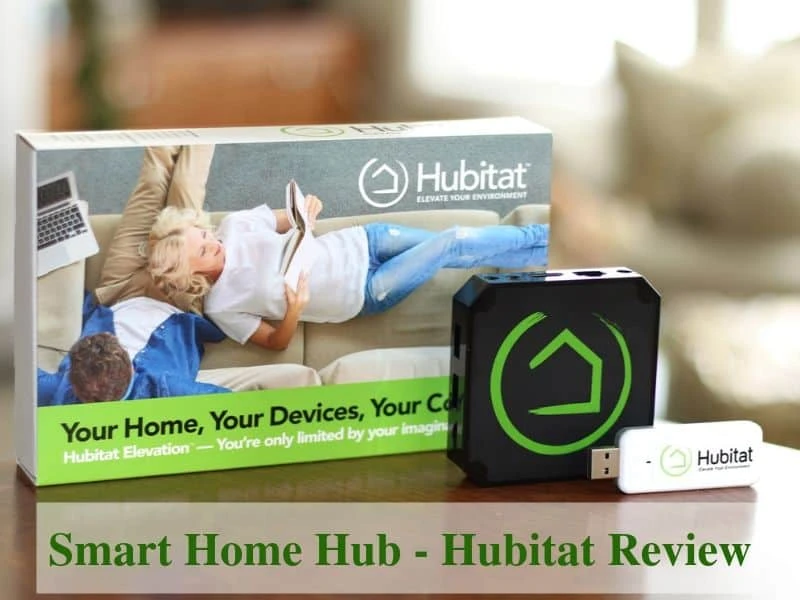If you have different smart home devices for everything - locks, security cameras, lights, motion sensors, garage doors, room temperature - a smart home platform to link everything can be a lifesaver.
I agree that wishing for a perfect smart home platform is a little like finding a unicorn --- impossible. But that doesn’t mean that nothing comes close.
Enter the Hubitat Elevation hub!
Hubitat vs. SmartThings
The Hubitat Elevation hub is a customizable smart home hub that can bridge the gap between different devices using Z-Wave and Zigbee, is platform agnostic and can work well with Google, Amazon, Apple and more. It promises total privacy and data security as it doesn’t use any cloud-based service (see other non-cloud home automation system ) but instead, is self-hosted and has local automation processing. It is affordable and costs $100 for the U.S version.
Plus, it doesn’t have any subscription fees!
The Hubitat is often compared to Samsung’s SmartThings Hub as it also can do both basic and complex automations. It is also compatible with Z-Wave and Zigbee. Hubitat though aims to do more by offering extensive customization options and creating more complex scenarios in controlling your smart home devices.
But, still no gesture control like the Fibaro Swipe yet!
The thing is, it might be the answer if you are a smart home guru or a techie. But for the average joe, it might be too much, as there is a real learning curve. It’s literally a blank canvas when you first use it, so setting it up can be a gargantuan task.
Size wise, it is almost half the size of the SmartThings hub and looks more like a thick coaster than a hub really. Ports are limited to micro USB and ethernet. Since it doesn’t use the internet, it needs to be plugged into your home router for it to work. It can be a downside not being able to place it anywhere but near your router, but for people looking for the security and reliability of local processing, it is worth it. No internet, no problem! The Hubitat will work fine. That cannot be said about SmartThings since it still relies on the cloud and can take a little longer to load the app or even just turn things on and off.
Price wise, SmartThings 2 is around $90 while SmartThings 3 is around $70, still in the same ballpark as that of Hubitat.
Many have said that Hubitat is better as it fixed all the things users have complained about withSmartThings. The only advantage of SmartThings is that it still is considered simpler and more user friendly, and for most home owners, it might be enough.
Battle for the DIY Home Automation Nerds: Hubitat vs. Home Assistant
Home Assistant, also called Hass.io, on the other hand is an open source software that you can run on any computer and is free of charge. You can just connect to a Raspberry Pi or other personal server that you keep plugged in at home and the system will be up and running. Similar to Hubitat, it runs locally and is super fast. It is also compatible to a number of devices and is practical to use if you have few automated things but for more complex automations, it can be limited and has a steep learning curve for setting up.
Unlike Hubitat however which has a one-time purchase cost which includes addition and connection to all devices, Home Assistant requires you to purchase a lot of things to connect to different devices and different softwares. For example, you have to pay $5 a month to connect to Google Assistant or Alexa and purchase a separate USB stick to connect to Z-wave or Zigbee. But then again, it is free of charge to use so all these additional costs may be justified.
Setting Up the Hubitat
The initial setup process starts with registering your hub in a web portal where you name your hub, enter your location and enter the main dashboard. This may be simple but the next step of adding your first device, figuring out the different technologies it uses like WiFi, Zigbee and Z-Wave is enough to confuse the average consumer.
Since it is literally a blank slate, there is nothing pre-installed. You need to install a number of apps to give the system a baseline of smart home functionality, i.e. Mode Manager - to set up the “I’m home” and “I’m away” mode in your house, the Rule Machine - to set things up automatically like turning lights on and off and setting the temperature in the entire room, and the most essential of all, the Dashboard manager - for control over everything in each room of your house. While it might be exciting for smart home enthusiasts to add and configure everything from scratch, that’s definitely not true for most people who want convenience at the onset. Once successful though, it really does the job.
Final Thoughts
While the Hubitat aims to provide more and be more than the usual smart home hubs available today, it simply is not for everybody. Setting it up is no easy task for a regular home owner. And if you just have the basic or few home automations like lights and locks, there are other available options for you which are far simpler and user-friendly (see our home automation system reviews article). The Hubitat is recommended for those smart home enthusiasts who do not mind the learning curve and is technically armed with know hows to set it up from scratch.

